 |
 |
 |
‘Build Your Own City’ report
on the Shanghai Bienniale by
Anthony Auerbach, published in German in Kulturisse,
No. 1 (Vienna, 2003), pp. 32–33.
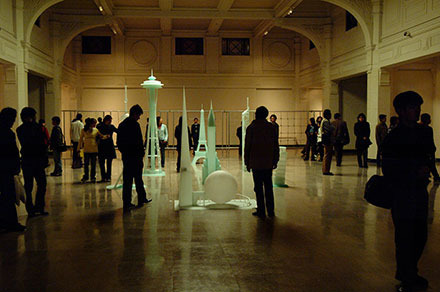
 The fourth Shanghai Biennale opened in November 2002 under the
banner ‘Urban Creation’. For me, like most visitors or exhibitors
from the west, the title did not suggest much to influence my expectations
of the event. We have learned what to expect from the circus of
international art fairs and biennials and have come to understand
them as just one of the phenomena of the symbiosis between modern
art and the city. It was the capitalist city, its institutions and
its markets that made the life of the modern freelance artist possible
in the first place and in return, Modernism paid tribute to its
bourgeois clientele. The ‘painter of modern life’ hailed in the
second half of the nineteenth century was synonymous with the painter
of urban life. It has been suggested that in all its diversity Modernism
is best defined as a set of prohibitions, among them the ban on
depictions of rural life, natural landscapes and landed property.
Although such prohibitions became relaxed in the post-modern era — with
the recuperation of the sublime and of kitsch — contemporary
art has largely upheld the orthodoxy established early in the last
century. Contemporary art in the west has furthermore kept pace
with industrial and now so-called ‘post-industrial’ society by excluding
the images of work, not to mention rural labour. While the market
for paintings celebrating the beauty of nature, rural idylls, country
sports and the like continues to flourish in Paris, London and New
York, along with the market for the direct consumption of landscape
through mass-tourism, the art institutions have vigorously defended
the restricted repertoire of what counts as contemporary art and
propagated a globalised norm by just such means as biennial exhibitions,
Guggenheim franchises and the like. So the curators of the Shanghai
Biennale could hardly go wrong with ‘Urban Creation’. It might be
banal, but it could not be irrelevant. The fourth Shanghai Biennale opened in November 2002 under the
banner ‘Urban Creation’. For me, like most visitors or exhibitors
from the west, the title did not suggest much to influence my expectations
of the event. We have learned what to expect from the circus of
international art fairs and biennials and have come to understand
them as just one of the phenomena of the symbiosis between modern
art and the city. It was the capitalist city, its institutions and
its markets that made the life of the modern freelance artist possible
in the first place and in return, Modernism paid tribute to its
bourgeois clientele. The ‘painter of modern life’ hailed in the
second half of the nineteenth century was synonymous with the painter
of urban life. It has been suggested that in all its diversity Modernism
is best defined as a set of prohibitions, among them the ban on
depictions of rural life, natural landscapes and landed property.
Although such prohibitions became relaxed in the post-modern era — with
the recuperation of the sublime and of kitsch — contemporary
art has largely upheld the orthodoxy established early in the last
century. Contemporary art in the west has furthermore kept pace
with industrial and now so-called ‘post-industrial’ society by excluding
the images of work, not to mention rural labour. While the market
for paintings celebrating the beauty of nature, rural idylls, country
sports and the like continues to flourish in Paris, London and New
York, along with the market for the direct consumption of landscape
through mass-tourism, the art institutions have vigorously defended
the restricted repertoire of what counts as contemporary art and
propagated a globalised norm by just such means as biennial exhibitions,
Guggenheim franchises and the like. So the curators of the Shanghai
Biennale could hardly go wrong with ‘Urban Creation’. It might be
banal, but it could not be irrelevant.
The Biennale offered sixty exhibits, half from China, picked by
Chinese curators and half chosen by ‘international’ curators (from
Japan, Germany and USA). Half of works were by artists and half
by architects. There seemed to have been no opportunity for the
Chinese curators to offer an interpretation of art production in
the developed economies and little interest on the part of the foreign
curators to get to know what is happening in China today. So, with
the spirit of internationalism there to prevent anyone from crossing
borders, it looked as if everything was going to be normal, complacent
and compliant. But like many things in Shanghai, for an outsider,
it is the similarities with what we are used to that really make
us loose our bearings. Like the drink that is sold in China in a
plastic bottle with a ‘sports’ cap like many brands of mineral water
or soft drinks, but which turns out to be 50% alcohol, the Shanghai
Biennale’s familiar packaging contained a startling ideological
substitution.
In China today, ‘Urban Creation’ is the main theme of the aggressive
development policy being pursued by the Communist government. Urbanisation,
industrialisation, modernisation and international integration constitute
the next ‘great leap forward’ towards establishing the ‘socialist
market economy’. China’s urban population has increased in the last
twenty years from about 20% to 30% of its total (now estimated at
1.3 billion) and it is expected that a further 12 million people
a year will leave the countryside in the coming years, making urban
dwellers 45% of the population by 2010. (At this rate the countryside
of Austria would be emptied in a matter of weeks.)
Shanghai is already a building site of 16.74 million inhabitants.
It is the largest city in China and the industrial, commercial and
financial centre of the world’s second largest economy (after USA).
From the top of the prestige eighty-eight storey Jin Mao Tower (developed
by the state-owned trade and finance concern Jin Mao) Shanghai’s
urban sprawl seems as if it is high-rise as far as the eye can see.
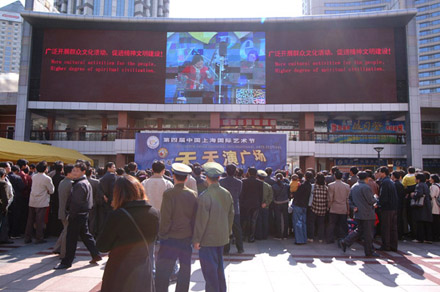
At street level, one is struck by a young city, vibrant commerce
(from street-sellers to department stores) and everywhere construction.
Even if a lot of the shiny new skyscrapers seem to be vacant from
the second floor up, the air is confident and busy. High-rise is
supposed to be a sign of rising land prices as demand for accommodation
outstrips supply in certain areas (this is the American model),
or it can be a sign of urban planning control where the city authorities
wish to create concentrated areas of economic activity (this is
the European model). In Shanghai, tall buildings seem to go up like
flags or banners, uninhibited by market forces or the kind of urban
planning we would recognise, as if for no other reason than to advertise
and celebrate urban creation.
As a foreigner moving through the city, one has to come to terms
with becoming illiterate. Chinese exists beyond the realm of the
alphabet that consoles with its legibility even when one does not
understand the language it inscribes. One also begins to doubt how
to ‘read’ the city. Shanghai is obviously sure of its future, but
it is being shaped in a way that doesn’t seem to go with the ABC
of urbanism learned from the historic cities of the west.
So, what could the city possibly have wanted from a biennial exhibition?
The official answer was advertised in the slogans for the city’s
arts festival — kindly translated for foreigners on a giant screen
in the People’s Park: ‘More cultural activities for the people,
Higher degree of spiritual civilization. — Serve the Mass, enter
the life of people! — Enhance the overall qualities of our citizens,
Promote the cultural civilization of our city — Welcome, Artists
from all over the World!’
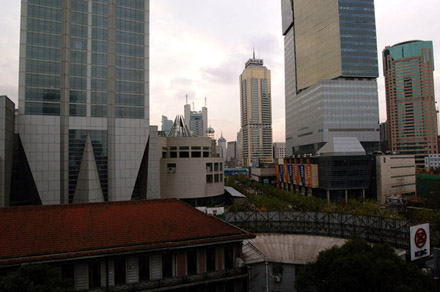
The People’s Park is what used to be the city’s race course and
the Shanghai Art Museum which hosted the biennial occupies what
was the main race course building from colonial times, now dwarfed
by skyscrapers on all sides.
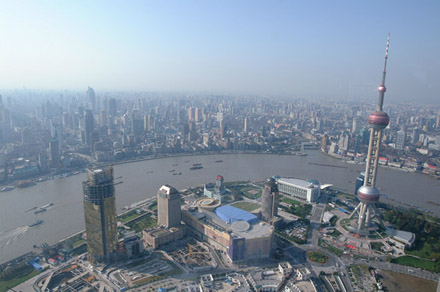
It seems almost pointless to criticise the collection
of leftovers and avatars of the European civilisation of the last
century it contained (though there was much to disappoint), when
it could hardly avoid being overwhelmed by its surroundings. The
exhibition seemed to be the result of an integration project carried
on at crossed purposes. But it is worth reflecting on architectural
contributions in the show. Allowing for the fact that the architects
invited had not been given any clear brief by curators more accustomed
to catalogue shopping, what was striking in the Shanghai context
was just how remote the institutionalised self-image of architecture
is from the forces which shape cities. The representative genres
(apart from trade-fair-type sales pitches) remain ‘master plans’
(the realisation of which has not been seriously considered except
under totalitarian regimes) or country houses. These are predominantly
narcissistic projects and it would be easy to dismiss them, but
in hesitating to dismiss them or be seduced by them, the question
arises of what role narcissism (mediated by visual culture) must
play in urban creation.
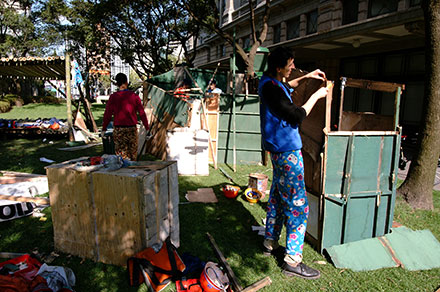
Perhaps the contribution that made the most sense in the biennial
was to be found just outside the museum and was the result of a
multiplicity of crossed purposes. The chief curator of the biennial
seems to have mistaken the four-man artist-group Gelatin for a group
of architects (according to her catalogue text). The boys arrived
early with tools but without any work to unpack, because they always
make their work in situ. Their original project proposal was rejected
because of worries it might be exploited by Falun Gong. They needed
to buy some materials. The curators promised to mention it at their
next committee meeting. Frustration was allowed to come to a head
before construction could start. Gelatin’s ‘Win-Win Project’, as
it was later entitled, was slum built in the museum garden: an improvised
dwelling and outside toilet, made from waste materials from the
biennial and odds and ends from the local market. In the end it
was the only space in the exhibition where any dialogue took place.
Anthony Auerbach, 2002
 ...
return: Urban matters ...
return: Urban matters
Images
Photographs by Anthony Auerbach
|
 |
 |
 |
 |
 |